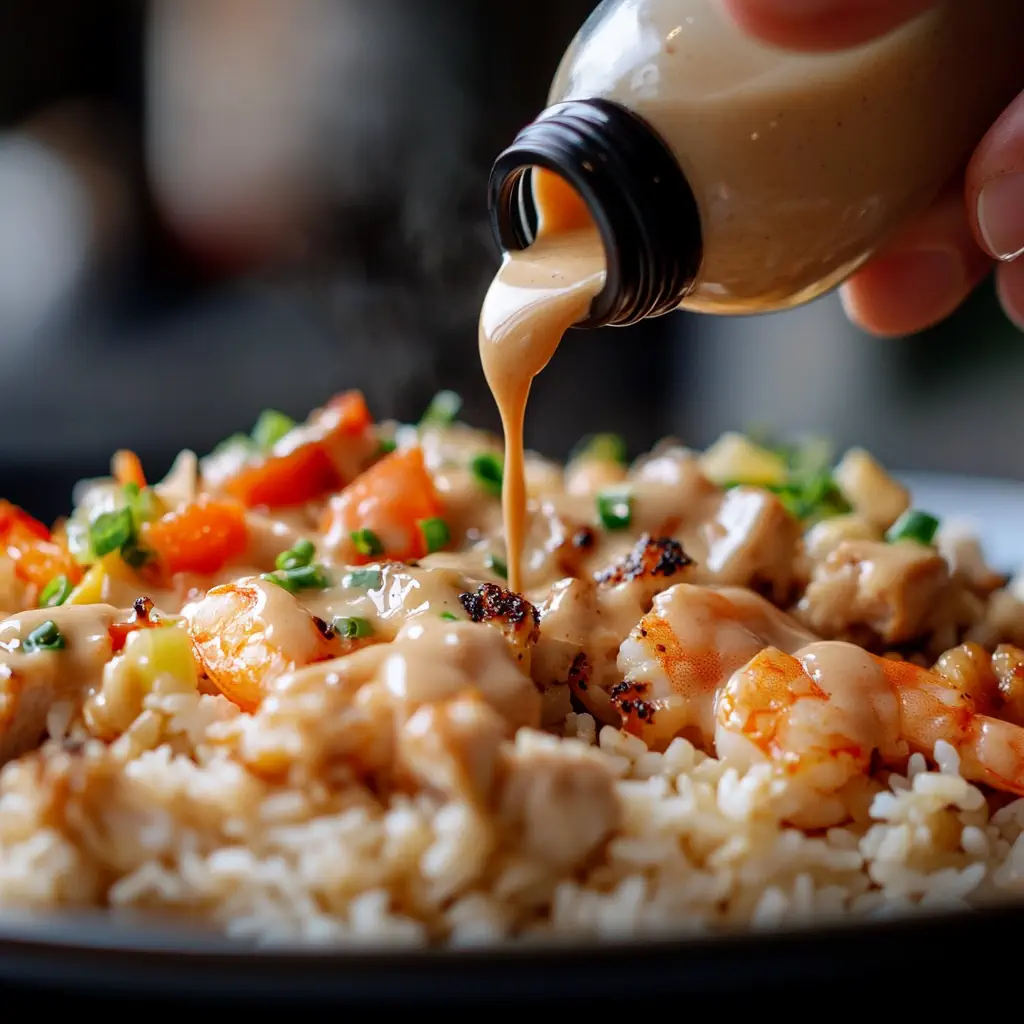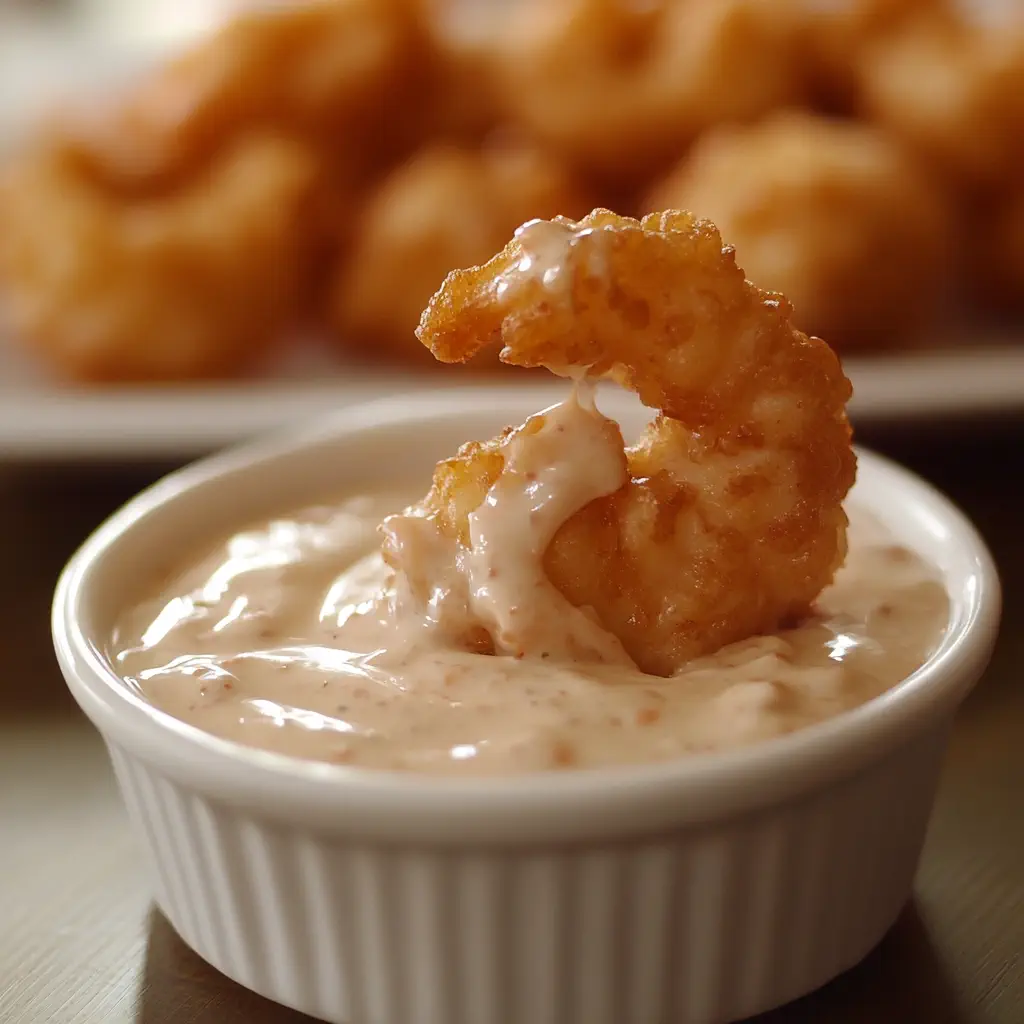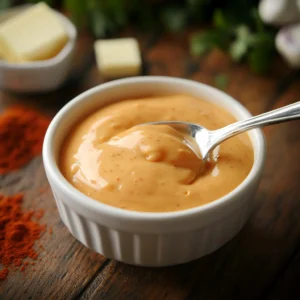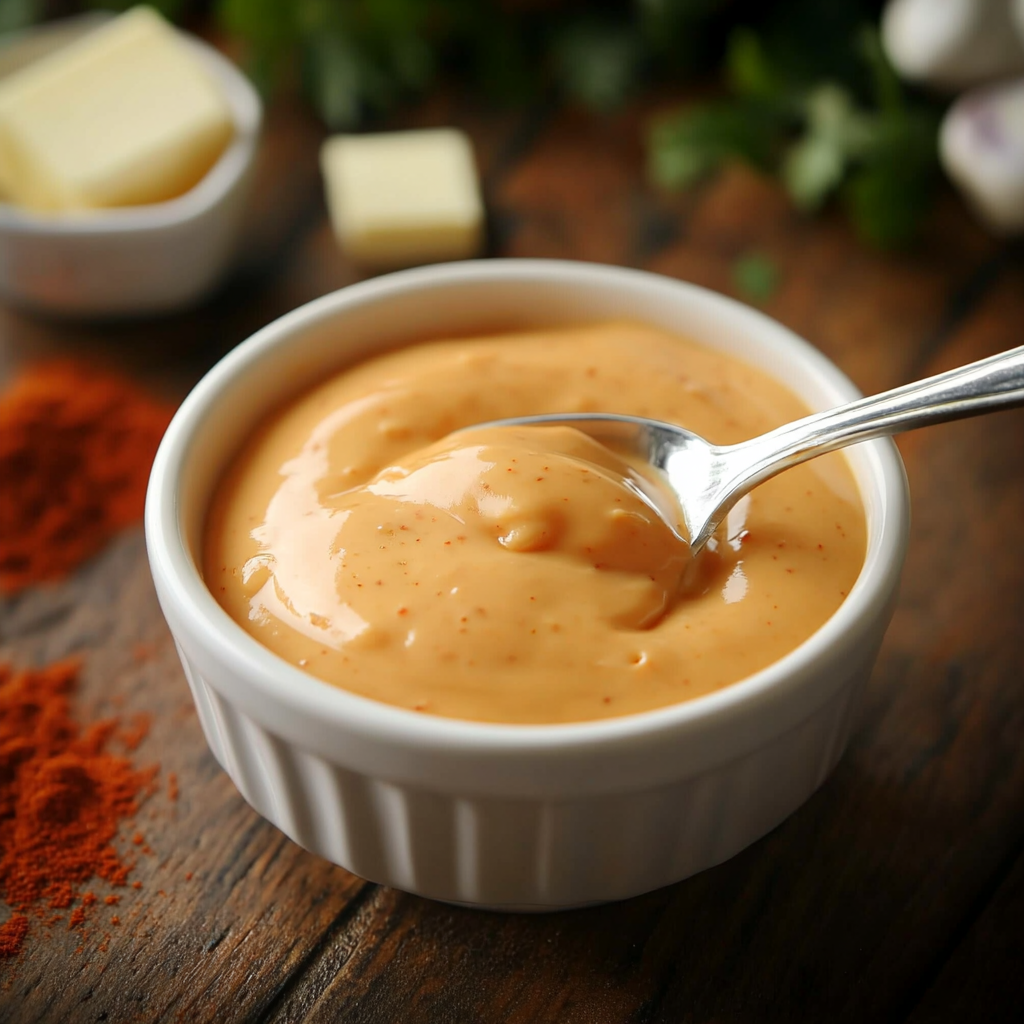Yum yum sauce is a creamy, slightly sweet, and tangy dipping sauce often served at Japanese steakhouses. It’s commonly used with hibachi-style dishes, such as grilled meats, fried rice, and vegetables.
Even though many people think it comes from Japan, yum yum sauce is actually an American creation! It became famous in hibachi restaurants across the U.S., and people loved it so much that they started making it at home.
Table of Contents
What Does Yum Yum Sauce Taste Like?
Yum yum sauce has a rich, smooth texture with a mix of sweet, tangy, and slightly smoky flavors. Some versions are a little spicy, while others have a stronger garlic or tomato taste. The balance of flavors makes it addictive—once you start dipping, it’s hard to stop!
What Is Yum Yum Sauce Made Of?
The basic ingredients of yum yum sauce are:
- Mayonnaise – The creamy base of the sauce.
- Tomato paste or ketchup – Adds a mild tangy flavor and color.
- Sugar – Gives it a touch of sweetness.
- Paprika – Adds a smoky taste.
- Garlic powder – Enhances the flavor.
- Butter – Adds richness.
- Water – Helps thin out the sauce for a smooth texture.
Some recipes also include:
- Sriracha or hot sauce – For a spicy kick.
- Rice vinegar – To enhance the tangy flavor.
- Soy sauce – For extra umami depth.
Other Names for Yum Yum Sauce
Different restaurants and people call yum yum sauce by different names. Some of the most common ones include:
- Japanese white sauce – Even though it’s not always white.
- Hibachi sauce – Because it’s often served with hibachi dishes.
- Shrimp sauce – Since it pairs perfectly with seafood.
No matter what you call it, this sauce makes any meal more delicious.
The History of Yum Yum Sauce
Many people think yum yum sauce comes from Japan, but that’s not true. This famous sauce was actually created in the United States! It became popular in Japanese steakhouses, especially hibachi-style restaurants, and soon became a must-have for many dishes.
Where Did Yum Yum Sauce Come From?
The exact origin of yum yum sauce is unclear, but many believe it was first introduced in Japanese hibachi restaurants in the U.S. These restaurants, which became popular in the 1960s and 1970s, featured chefs cooking on large flat grills in front of customers.
One chef decided to create a special creamy, slightly sweet sauce to serve with steak, shrimp, rice, and vegetables. Customers loved it so much that they started asking for extra sauce. Over time, it became a signature condiment in many Japanese steakhouses.
Why Is It Called “Yum Yum Sauce”?
The name “yum yum sauce” comes from how people reacted to it. They would take one bite, say “yum!” and ask for more. Some restaurants even started calling it “Japanese yum yum sauce” to make it sound more authentic.
How Did It Become So Popular?
At first, yum yum sauce was only found in Japanese steakhouses. But as more people tasted it, they wanted to enjoy it at home. Restaurants and food brands noticed this demand, so they started selling bottled versions in grocery stores.
Now, yum yum sauce is available almost everywhere. People use it not just for hibachi meals but also for burgers, fries, sandwiches, and even salads. Some creative food lovers even mix it into pasta dishes!
Yum yum sauce has gone from a restaurant secret to a household favorite. And with so many ways to use it, it’s easy to see why!

Ingredients Used in Yum Yum Sauce
| Ingredient | Amount | Purpose |
|---|---|---|
| Mayonnaise | 1 cup | Creamy base of the sauce |
| Tomato paste/ketchup | 1 tablespoon | Adds color and mild tanginess |
| Sugar | 1 teaspoon | Balances the flavors with sweetness |
| Paprika | 1 teaspoon | Adds a mild smoky flavor |
| Garlic powder | ½ teaspoon | Enhances the overall taste |
| Butter (melted) | 1 tablespoon | Adds richness and smooth texture |
| Water | 2-3 tablespoons | Thins the sauce for the perfect consistency |
| Rice vinegar | 1 teaspoon | Adds a subtle tangy kick |
| Optional: Sriracha or hot sauce | ½ teaspoon | For a spicy version |
This is the classic version of yum yum sauce, but many people love to customize it!
Instructions:
- Melt the butter in a small bowl and let it cool slightly.
- In a mixing bowl, combine mayonnaise, tomato paste (or ketchup), sugar, paprika, and garlic powder.
- Pour in the melted butter and stir well.
- Add water, one tablespoon at a time, until you reach your desired consistency. The sauce should be smooth but not too thin.
- Mix in the rice vinegar to add a light tangy kick.
- Taste the sauce and adjust the seasonings. If you like it sweeter, add a little more sugar. Want it spicier? Add a dash of sriracha or hot sauce.
- Cover and refrigerate for at least 1 hour before serving. This helps the flavors blend together.
Pro Tips for the Best Yum Yum Sauce:
- Let it rest: The sauce tastes better after sitting in the fridge for at least 1 hour.
- Use high-quality mayo: Japanese-style mayo (like Kewpie) makes the sauce even richer.
- Adjust the thickness: If the sauce is too thick, add a little more water. If it’s too thin, add a bit more mayo.
Common Mistakes to Avoid
Making yum yum sauce is easy, but here are some mistakes to watch out for:
- Using too much ketchup or tomato paste – This can make the sauce too tangy or red. Stick to the recommended amount.
- Skipping the resting time – If you eat the sauce right away, the flavors won’t be as strong. Refrigerating it makes a big difference!
- Adding too much water – This can make the sauce runny. Add water slowly and mix well before adding more.
- Not using melted butter – Butter gives the sauce a smooth, rich texture. Don’t skip this ingredient!
Once your yum yum sauce is ready, you can store it in the fridge and enjoy it for up to a week. Now that you know how to make it, let’s explore the best ways to use it!

Health Benefits and Nutrition Facts
Yum yum sauce is delicious, but is it healthy? The answer depends on how much you eat and the ingredients you use. While homemade yum yum sauce allows you to control what goes in, store-bought versions may contain preservatives and extra sugar.
Let’s take a closer look at the nutritional facts and ways to make a healthier version of this popular sauce.
Nutrition Facts of Yum Yum Sauce
Here’s the average nutrition breakdown for 1 tablespoon (15g) of yum yum sauce:
| Nutrient | Amount per 1 Tbsp |
|---|---|
| Calories | 80-100 kcal |
| Total Fat | 9g |
| Saturated Fat | 1.5g |
| Cholesterol | 5mg |
| Sodium | 90-120mg |
| Carbohydrates | 1-2g |
| Sugar | 1g |
| Protein | 0g |
What Does This Mean?
- High in calories – Because the sauce is made mostly of mayonnaise and butter, it is calorie-dense.
- High in fat – Most of the fat comes from mayonnaise, which contains healthy unsaturated fats but also some saturated fat.
- Low in carbs and sugar – Compared to many other condiments, yum yum sauce is not very high in sugar.
- Moderate sodium content – Some store-bought brands may have higher sodium levels, so check the label if you are watching your salt intake.
Is Yum Yum Sauce Healthy?
Yum yum sauce is not the healthiest sauce, but it can be part of a balanced diet when eaten in moderation. Since it’s high in fat and calories, it’s best to use small amounts rather than drenching your food in it.
Healthier Alternatives for Yum Yum Sauce
If you love yum yum sauce but want a lighter version, here are some ways to make it healthier:
- Use Greek Yogurt Instead of Mayonnaise
- Greek yogurt has less fat and fewer calories while still being creamy.
- It also adds protein and makes the sauce more nutritious.
- Choose Light or Vegan Mayonnaise
- Light mayo has fewer calories than regular mayonnaise.
- Vegan mayo is egg-free and lower in cholesterol.
- Reduce the Butter
- Butter adds richness, but cutting it in half will lower calories and fat.
- You can also replace it with olive oil for a healthier fat source.
- Use Natural Sweeteners
- Instead of white sugar, try honey or maple syrup in small amounts.
- These add sweetness while providing some natural nutrients.
- Lower the Sodium
- Store-bought sauces may have extra salt, so making it homemade helps control sodium levels.
- Use low-sodium soy sauce or rice vinegar for flavor without too much salt.
- Add More Spices Instead of Sugar
- To boost flavor without extra sugar, add:
- Cayenne pepper for spice.
- Smoked paprika for a richer taste.
- Fresh garlic instead of garlic powder for a stronger flavor.
- To boost flavor without extra sugar, add:
Is Yum Yum Sauce Keto-Friendly?
Yes! Yum yum sauce is naturally low in carbohydrates, making it keto-friendly if eaten in small amounts. However, some store-bought versions may contain added sugars, so check the label.
To make a keto-friendly version, simply:
- Skip the sugar or use a sugar-free sweetener like stevia or erythritol.
- Use full-fat mayonnaise for healthy fats.
- Add extra spices for bold flavor without added carbs.
Is Yum Yum Sauce Gluten-Free?
Most homemade yum yum sauce recipes are naturally gluten-free because they don’t contain wheat-based ingredients. However, some store-bought brands may contain gluten in preservatives or added flavorings.
To make sure your sauce is gluten-free:
- Always check labels when buying bottled yum yum sauce.
- Use gluten-free soy sauce or tamari if adding soy sauce to the recipe.
- Make it at home to control all the ingredients.
Final Thoughts on Yum Yum Sauce and Health
Yum yum sauce is a tasty treat, but it’s best to enjoy it in moderation. If you’re trying to eat healthier, consider making a lighter version at home using Greek yogurt, less butter, and natural sweeteners.
No matter how you enjoy it, yum yum sauce makes meals more exciting and delicious. Now, let’s talk about the best ways to store it and keep it fresh!
More inspiring eats you can’t miss:
- Vibrant Piped Rainbow Shortbread Cookies
- St. Patrick’s Day Brownie Trifle Dessert
- Sno Ball Brownies Recipe
- Boozy Jello Candy Melts (Without Alcohol)
- Rainbow-Filled Doughnuts recipe
Frequently Asked Questions
1. Can I Make Yum Yum Sauce Without Mayonnaise?
Yes! Use Greek yogurt, sour cream, or vegan mayo as a substitute.
2. Does Yum Yum Sauce Taste Good with Seafood?
Yes! It pairs perfectly with shrimp, fish, crab cakes, and sushi.
3. How Can I Make Yum Yum Sauce Less Sweet?
Reduce the sugar or add more vinegar, garlic, or paprika to balance the flavors.
4. What’s the Best Way to Store Yum Yum Sauce?
Keep it in an airtight container in the fridge for up to one week.
5. Can I Make a Low-Carb Version?
Yes! Use sugar-free sweeteners like stevia or erythritol to make it keto-friendly.
6. Is Yum Yum Sauce Gluten-Free?
Usually, yes! But always check labels if buying store-bought versions.
Conclusion
Yum yum sauce is a creamy, sweet, and tangy condiment that makes any dish more delicious. Though often served at Japanese steakhouses, it has become a kitchen staple for many people around the world.
With just a few simple ingredients, you can make homemade yum yum sauce that tastes even better than store-bought. Whether you dip, drizzle, or spread it, this sauce pairs perfectly with grilled meats, seafood, fries, rice, and even burgers.
For a healthier version, try using Greek yogurt, less sugar, or vegan mayo. If stored properly, homemade yum yum sauce can last up to a week in the fridge.
Now that you know everything about yum yum sauce, it’s time to make your own and enjoy it! 😋
More inspiring eats you can’t miss:
Vibrant Piped Rainbow Shortbread Cookies
The Story Behind These Cookies The first time I made these vibrant rainbow shortbread cookies was for my niece’s baby shower. Seeing everyone’s amazed reactions convinced me that this recipe had to be shared! Don’t let their sophisticated look fool you—these cookies are surprisingly easy to make! These beautifully buttery and colorful shortbread cookies are…
St. Patrick’s Day Brownie Trifle Dessert
Looking for a show-stopping dessert to celebrate St. Patrick’s Day? This St. Patrick’s Day Brownie Trifle is the ultimate festive treat! With layers of rich chocolate brownies, fluffy minty cream, and luscious whipped topping, this green-and-chocolate delight will be the star of your celebration. Whether you’re hosting a party or just craving something special, this…
Sno Ball Brownies Recipe
If you love rich, fudgy brownies and nostalgic coconut-covered Sno Balls, you’re in for a real treat! Sno Ball Brownies combine the best of both worlds—gooey, chocolatey brownies topped with a luscious marshmallow layer, coated in coconut. They’re the perfect dessert for special occasions, holidays, or just when you’re craving something sweet and indulgent. Let’s…

yum yum sauce
Ingredients
- 1 cup mayonnaise
- 2 tablespoons ketchup
- 1 tablespoon rice vinegar
- 1 tablespoon mirin or substitute with a little sugar and extra vinegar
- 1 teaspoon garlic powder
- 1 teaspoon onion powder
- 1 tablespoon melted butter
- 1 teaspoon smoked paprika
- 1 –2 tablespoons water adjust for desired consistency
- ½ teaspoon cayenne pepper optional for a little heat
- Salt to taste
Instructions
- In a bowl, whisk together mayonnaise, ketchup, rice vinegar, mirin, and melted butter.
- Add garlic powder, onion powder, paprika, and cayenne pepper. Stir until fully combined.
- Slowly add water, one tablespoon at a time, until you reach the desired consistency.
- Taste and adjust seasoning with salt if needed.
- Cover and refrigerate for at least 30 minutes to let the flavors meld.
- Serve with hibachi-style grilled meats, seafood, or rice!
Video
Notes
- For a sweeter sauce, add an extra teaspoon of sugar.
- If you prefer a spicier kick, increase the cayenne or add a little Sriracha.
- Store in an airtight container in the fridge for up to one week.




